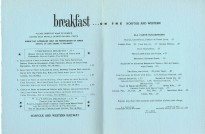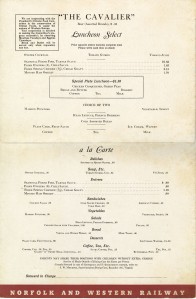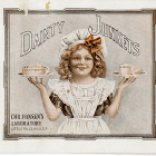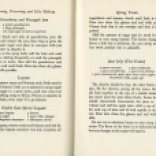This week’s Women’s History Month profile is going to a little different. Anyone who has followed this blog (or our general Special Collections blog) for a while knows that we deal with mysteries a lot. Sometimes, despite all the digging, people, places, events, and even ingredients can remain shrouded in secrets. And that’s okay. Frustrating (believe me, I know!), but okay. It doesn’t mean they can’t leave a legacy. Which is how we get to Miss M. L. Tyson, the “Queen of the Kitchen,” and her 1,007 recipes.
Published in 1886, The Queen of the Kitchen: A Collection of Southern Cooking Receipts Containing over One Thousand Southern Receipts in Practical Cookery is an anthology of recipes, recipes, and more recipes, along with a few sets of household management instructions thrown in for good measure (because how else will you get rid of that vermin problem?). Our mysterious Miss Tyson doesn’t take credit for writing everything, but she does claim compilation of generations of family receipt books and, as we’ll see from a Marylander, plenty of seafood. (I am deliberately not getting into geographical disputes about whether Maryland is southern enough, especially since we’ll see plenty of southern influence.)
On the “table of contents” surface, The Queen of the Kitchen has the same categories and general topics/subjects we expect in a work of this sort from this time. So, in that sense, it’s not entirely unique. At the same time, it brings together traditionally southern cooking and techniques with a strong Mid-Atlantic coastal influence. First, some recipes:
I started out with breakfast, since I had pancakes on the brain when I launched into this blog post. Whatever you to want to call them–pancakes, cakes, johnny cakes, cream cakes, saleratus cakes, clabber cakes, mush cakes, Washington breakfast cakes, etc.–Miss Tyson has a LOT of them. There’s plenty of seafood in this book, and in my typical style, I found a page with some more…interesting recipes, but for good reason! When we’ve looked at some early American cookery on the blog in the past, we’ve talked a fair bit about the British influence. Eventually, much that started to go away (though not all of it) as America found it’s vast and varied culinary culture. Miss Tyson’s ancestors, it seems, didn’t lose as much of that–suggested by the eel and cod. Cod tongues on its own is a striking recipe. Cod sounds, for those of you not up on your fish biology, are swim bladders. The recipe is a bit more common in British cooking, as is eel, but it also points to an important trend in 19th century American cookery–economy!
I skipped ahead to dessert after that, where we once again see the British influence in the section on custards and jellies. Blanc mange itself was common in the 19th century, but the idea of a “Yellow” one, which seems to be based on the resulting colo(u?)r, rather than the contents, was rather intriguing. I also like the idea of arrow root as a thickener, which has a long history as such. Since we can never escape food preservation technologies in the American culinary history, neither could Miss Tyson. Among her many recipes are TWO for cucumber catsup. We’ve certainly looked a catsup before on the blog, and the fact that it took a long time to get to the tomato kind we know today. I sort of expected cucumber catsup to more like a chow-chow or relish of some sort. In this case, it is kind of a cross between a relish and a pickle and was probably a condiment/accompaniment of some sort.
And lastly, because we’re in Virginia, it only seemed right to end a recipe that would have some weight here: ham! The recipes above are immediately preceded by “To Cure 1000 Pounds of Pork” and succeeded by “Westphalia Mode of Curing Hams,” after the book goes on to the topic of meat. The Westphalia recipe, while referring to a region of Germany, explicitly states that “[t]his receipt was brought from England by a gentleman who used it with great success.” So while Miss Tyson herself seems to be a self-proclaimed American “Queen of the Kitchen,” it’s important to note her somewhat world-wide and nation-wide influences.
Unfortunately, there wasn’t much to go on in terms of identifying our Miss Tyson. “Queen of the Kitchen,” sadly, does not appear on any census records. I wasn’t able to come up with a first name and the initials alone aren’t really enough to narrow down a search. This is also, it appears, Miss Tyson’s only work–a sort of opus, it seems. The Queen of the Kitchen is available online from Virginia Tech, if you’d like to delve further into its 428 pages and 1,007 recipes. There’s plenty of learn about jellies, ice creams, seafood, meet, and more! There was a previous edition in 1882, but, as far as WorldCat indicates, nothing before that.
On a related note, there’s a fun new hashtag out there on Twitter and other forms of social media: #FoodFriday. If you’re a social media user, especially on Twitter, you should keep an eye on it. Since I’ve been posting on Fridays a lot lately and because of this trend, I am tentatively looking at moving my posting schedule toward Fridays. Or at the very least, tweeting about blog posts on Fridays–and maybe some other things! If you are on Twitter and aren’t following us yet, you can find us @VT_SCUA, where we talk about Special Collections generally, as well as our many collecting areas, including culinary history.






















































![Kellogg's Recipes [cards] Kellogg's Recipes [cards]](https://whatscookinvt.files.wordpress.com/2015/01/ms2011_002_kellogg_cards4.jpg?w=243&resize=243%2C148&h=148#038;h=148)
![Kellogg's Recipes [cards] Kellogg's Recipes [cards]](https://whatscookinvt.files.wordpress.com/2015/01/ms2011_002_kellogg_cards5.jpg?w=243&resize=243%2C138&h=138#038;h=138)
![Kellogg's Recipes [cards] Kellogg's Recipes [cards]](https://whatscookinvt.files.wordpress.com/2015/01/ms2011_002_kellogg_cards3.jpg?w=296&resize=296%2C171&h=171#038;h=171)
![Kellogg's Recipes [cards] Kellogg's Recipes [cards]](https://whatscookinvt.files.wordpress.com/2015/01/ms2011_002_kellogg_cards2.jpg?w=296&resize=296%2C170&h=170#038;h=170)
![Kellogg's Recipes [cards] Kellogg's Recipes [cards]](https://whatscookinvt.files.wordpress.com/2015/01/ms2011_002_kellogg_cards6.jpg?w=296&resize=296%2C168&h=168#038;h=168)
































































